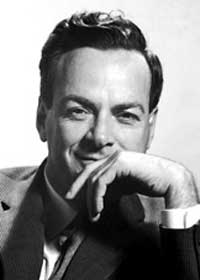I love reading about quantum physics. I have always thought that if you can learn how subatomic particles behave, you can learn anything. In the past three years, for an hour every day, I have read on this subject, including the many fascinating personalities involved in its study. One of the most intriguing is Richard Feynman (1918-1988), widely viewed as the top quantum physicist of his time. James Gleick's book on Feynman, Genius: The Life and Science of Richard Feynman, is both incredibly informative and inspiring.
Gleick outlines Feynman's career -- from his beginnings as a boy genius in math to receiving a Ph.D. at Princeton, from his work on the Manhattan Project and the atomic bomb at Los Alamos in World War II to his many achievements afterwards. One of the highlights of the book is the famous question that Feynman posed to himself, slightly paraphrased, "If, through some cataclysm, all scientific knowledge were to be lost, and only one sentence could be passed on to the following generations, what single statement would contain the most information in the fewest words?"

Feynman's one sentence, to pass onto to future generations, was the atomic hypothesis. He said, "all things are made of atoms -- little particles that move around in perpetual motion, attracting each other when they are a little distance apart, but repelling upon being squeezed into one another." "In that one sentence, you will see, there is an enormous amount of information about the world, if just a little imagination and thinking are applied," said Feynman about his one sentence.
For me, just the framing of that question by Feynman is brilliant. And, I often think of what my own piece of information, my one sentence, would be.
Although after a great deal of thought, during which I almost agreed with Feynman, I decided to go with the insight of supply and demand curves. A key concept there is that prices are determined by their marginal value; and this concept was not discovered until 1871 -- when it was simultaneously arrived at by Menger, Walrus and Jevons.
Perhaps, the greatest economist of all time, Richard Cantillion had almost gotten it. In "Essai sur la Nature du Commerce in Général" (Essay on the Nature of Trade in General, 1736), he discussed the role of the entrepreneur in the market and creation of prices. But, it was 184 years before everything came together -- and the actual diagrams of supply and demand were drawn in 1920 by Alfred Marshall in his classic book Principles of Economics.
Before that, the Labor Theory of Value, first presented by Adam Smith in the Wealth of Nations, framed how most people thought about value -- it was a flawed theory.
This mistake was repeated by David Ricardo and many other economists until Karl Marx furthered this theory to a new level when he based his idea that the state should have total control over the means of production. In Das Kapital, Marx argued that every price should be set scientifically, with the unit of measurement set according to the number of hours required by production. This argument took the world back in time -- both intellectually in economic theory, and politically, by giving birth to the horrors of Marxist, Leninism, and communism.
Finally, the big breakthrough came in 1871, by Menger, Walras and Jevons showing value was in the eyes of the beholder. Hence it was subjective -- different for each person, depending on their own wants and desires. This insight had great political repercussions as well. It became an argument in favor for allowing each person to determine their future. Because of the subjectivity of value, one adult person could not tell another what was good for them.
But, still missing was a comprehensive, visual representation of how prices are determined. Then, the Cambridge Professor Marshall came along, creating the mental construct of supply and demand curves that could be illustrated graphically. Suddenly, even a school child could understand the importance of supply and demand and how they interacted together to determine price.
The next breakthrough was by F.A Hayek in "The Use of Knowledge in Society," published in the American Economic Review in 1946. There, Hayek showed us that prices communicate information to people about the relative scarcity of goods. Later, he furthered this idea with the following insight: each human being has unique knowledge of time and place and product. From this came my own life's work that low-income youth can compete in markets by learning about their comparative advantage through entrepreneurial education. In my opinion, for this paper, Hayek was to win the Nobel Prize for Economics in 1974. And, teaching comparative advantage with the entrepreneurial mind frame to low income youth maybe the most important insight in youth work of our time and our best shot to end worldwide youth employment.
So my answer to Feynman's question is this, and I quote from innumerable textbooks:
In microeconomics, supply and demand is an economic model of price determination in a market which concludes that in competitive markets the unit price for a particular good will vary until it settles at a point where the quantity demanded by consumers (at current price) will equal the quantity supplied by producers (at current price), resulting in an economic equilibrium for price and quantity.
I hope that everyone will take the time to answer Richard Feynman's question.
What is your sentence that you would pass along to others?
